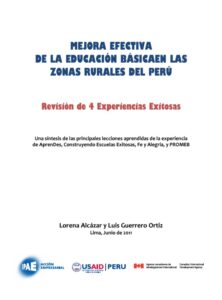Mejora efectiva de la educación básica en las zonas rurales del Perú
| Year | : | 2011 |
|---|---|---|
| Author/s | : | Lorena Alcazar |
| Area/s | : | Methodologies for research and evaluation of policy and programmes |
Alcázar, L. y Guerrero Ortíz, L. (2011). Mejora efectiva de la educación básica en las zonas rurales del Perú. Lima: IPAE; USAID; Agencia Canadiense de Desarrollo Internacional.
The different models of intervention in rural schools analyzed in this mimeo: AprenDes, PROMEB, Building Successful Schools, Fe y Alegría, have given rise to experiences considered successful not only because they have fully complied with the most substantive of their main objectives, but also because of a fact of great political relevance: in four years of systematic intervention, rural school boys and girls who achieved basic or satisfactory performance in reading comprehension reached in general the following percentages: first grade: 52%, third grade: 55%, sixth grade: 65%. If we take into account that the historical average of satisfactory performance in reading comprehension for rural schools is around one child out of every 10 who goes on to third grade and even completes primary school, we can understand its enormous relevance for public policies.







